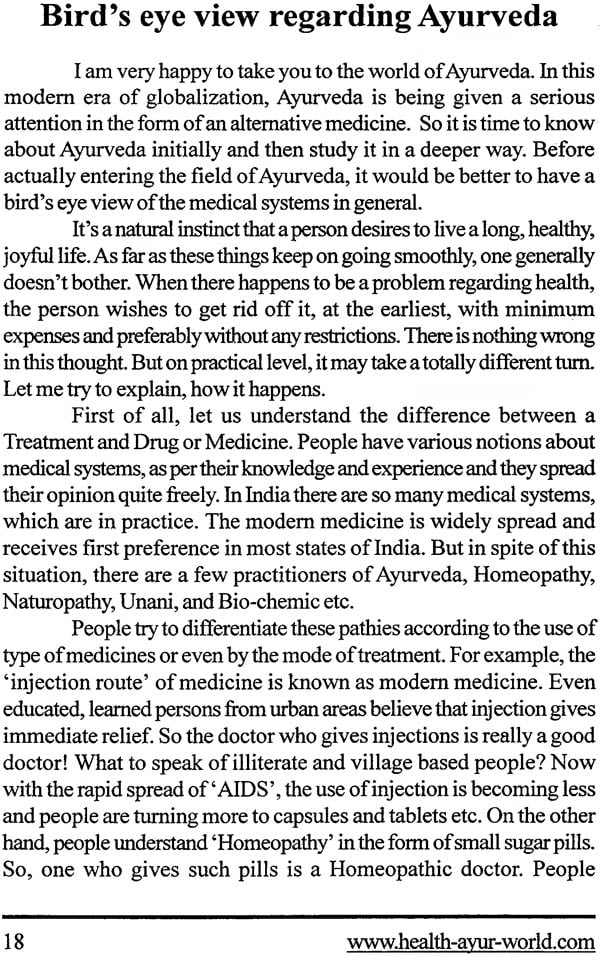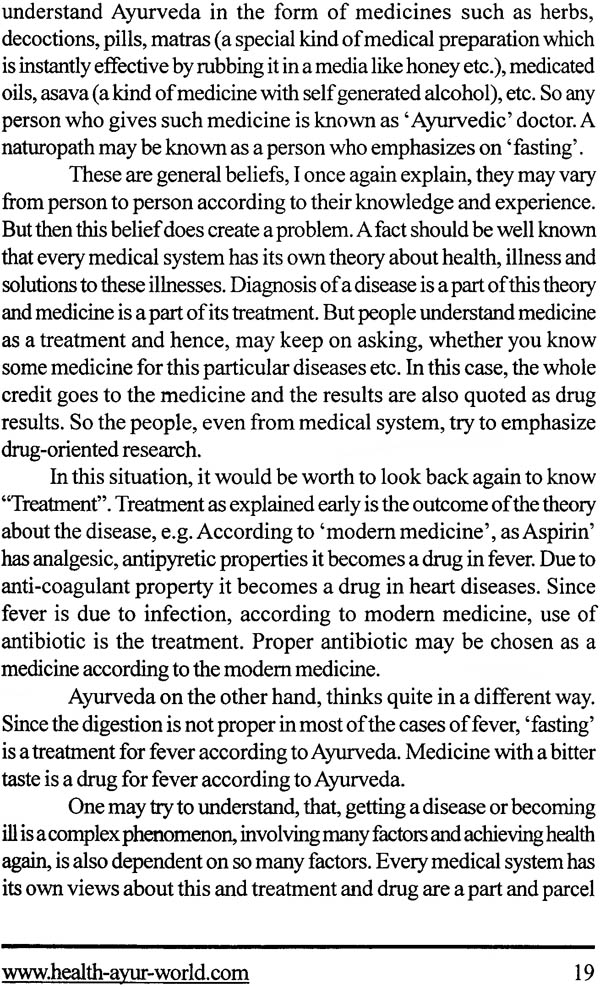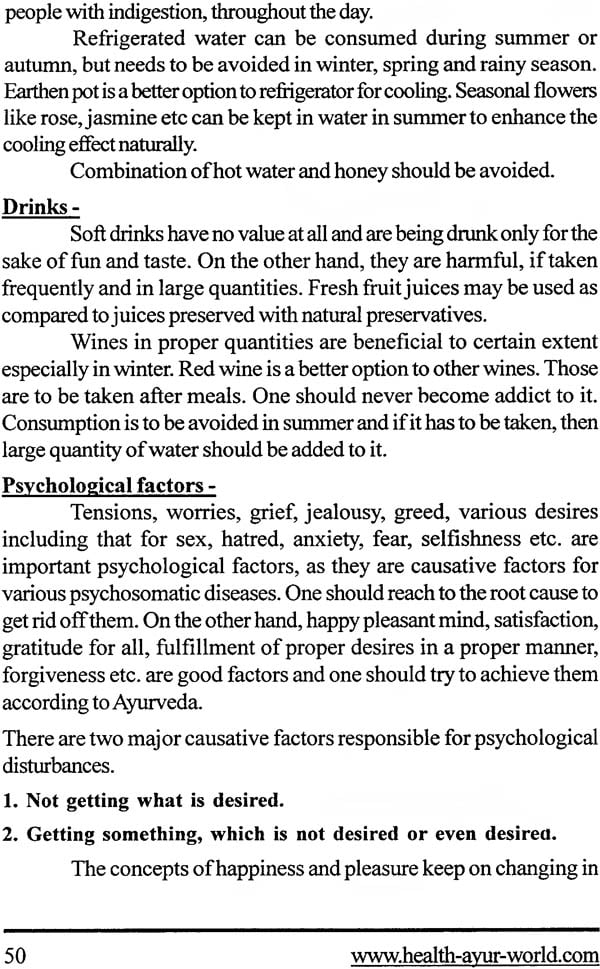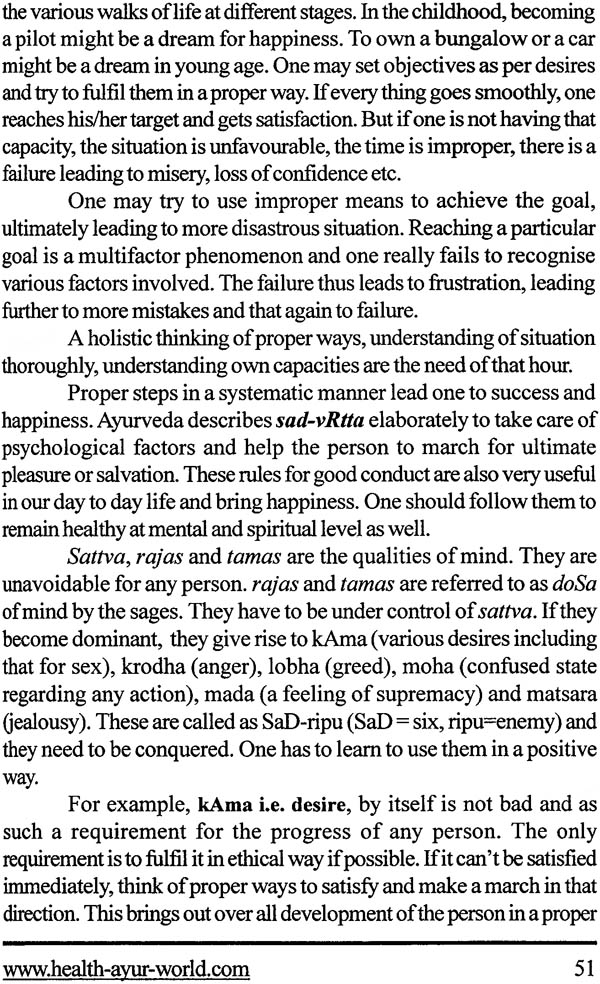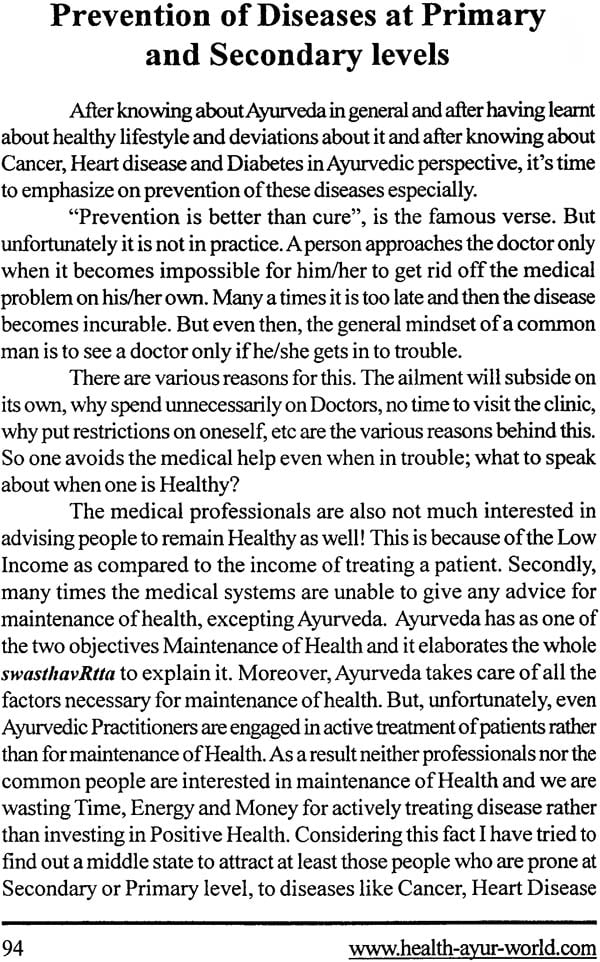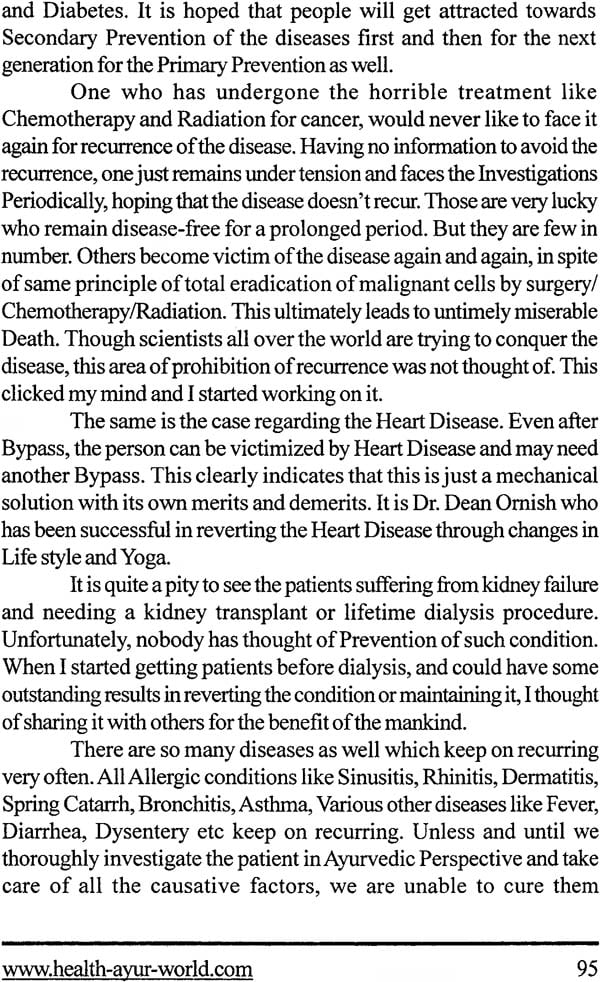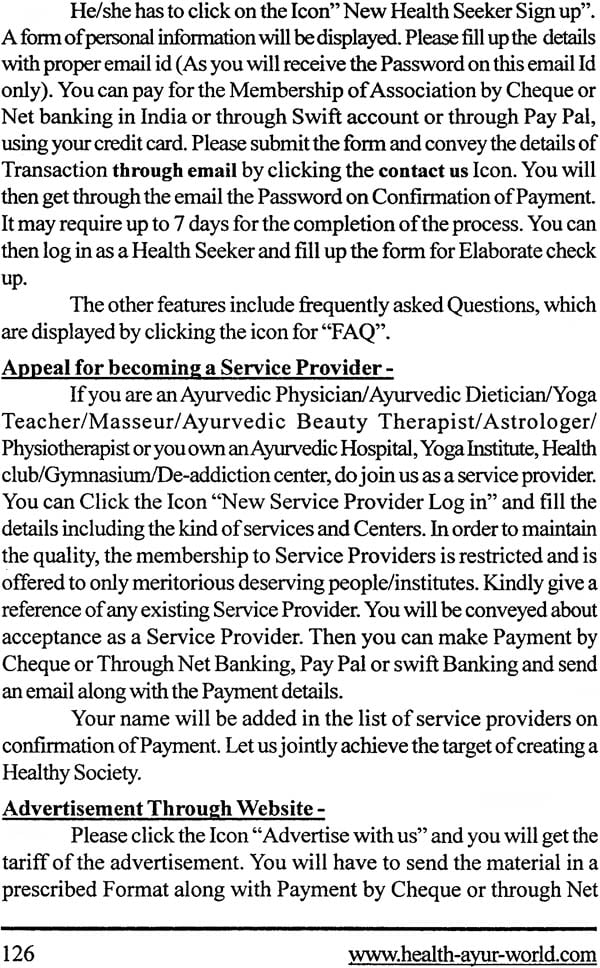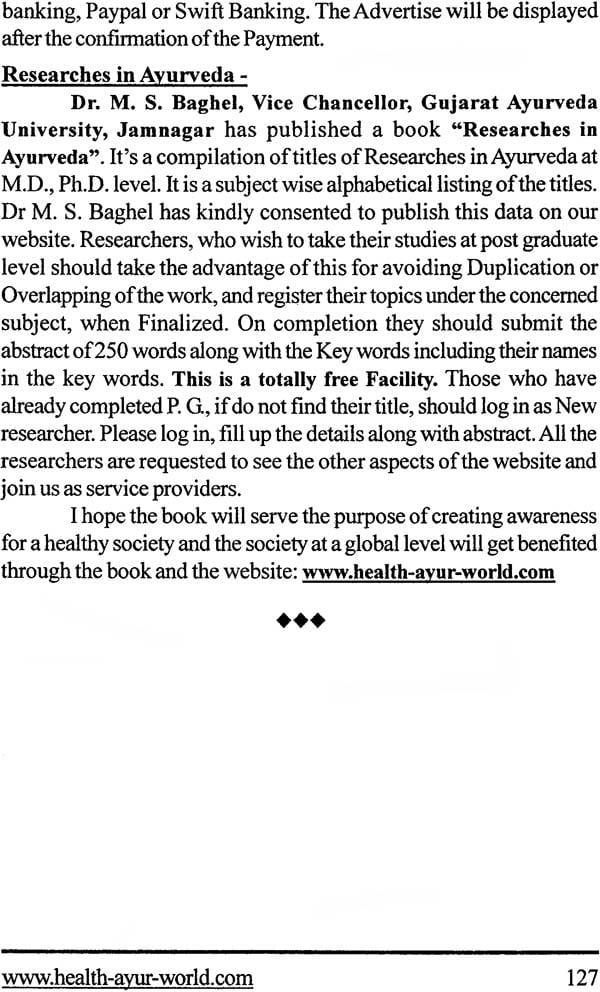
Cancer, Heart Disease and Diabetes Prevention and Treatment in Ayurvedic Perspective
Book Specification
| Item Code: | NAM403 |
| Author: | Dr. Dilip P. Gadgil |
| Publisher: | Manakarnika Publications, Pune |
| Language: | English |
| Edition: | 2017 |
| Pages: | 128 (12 B/W Illustrations) |
| Cover: | Paperback |
| Other Details | 8.5 inch X 5.5 inch |
| Weight | 170 gm |
Book Description
Dr. (Vaidya) Dilip Prabhakar GadgilM.D., Ph.D. (Ayurveda), M.Phil (Sanskrit),
An academician, practitioner and r
esearcher in the field of Ayurveda. Date of Birth – 13th /May 1955.
Ex Principle Investigator Atyrvediyah Triskandha-Kosha
CHIE Editor – Hetu-Kosha, Lakshana-Kosha, and Aushadha-Kosha, AYUTA NIDANA (Ayurvedic Diagnostic Software),
AYUTA UPCHARA (Ayurvedic Treatment Software)
Private Ayurvedic Consultant since 1980.
Hon. Ayurvedic Consultant – Deenanath Mangeshkar Hospital, Pune.
Regular visitor to various countries like Australia, Germany, UK, US.
Recipient of various awards including Vaidya Shivnath Sharma award at the hands of How. Vice President of India.
Felicitation at the hands of Hon. Chief Minister of Maharashtra State.
Ayurveda is possibly the earliest formal system of health care It is no mere compendium of therapeutic recipes as many other systems tend to be. Ayurveda is one of the earliest frameworks that systematized knowledge of health and health care. Its framework is not only self-consistent, but also uses cause and effect argument to correlate manifestations of sickness, its causes and its treatment. When this framework was developed in ancient India – the notion of a molecule did not exist, no was the cell and role it plays in the life process known. The discoveries of DNA and functional genomics lay more the 3000 years in the future, yet in spite of all this Ayurveda offered effective treatment for many disorders, particularly those with multiple causes.
The book by Dr. Dilip Gadgil is an interesting addition to the growing literature on Ayurveda. Written in personal style, it is also a personal viewpoint developed after years of study and experience. The book brings out the general concept of health and disease according to Ayurveda in a very meaningful way. His prescription of what constitutes a healthy life style according to Ayuveda isvery interesting.
Dr. gadgil deals with many misconceptions in ayurveda. These pertain to the questioning of the very scientific basis of Ayurveda, about Ayurveda being looked at as last resort after all the other methods of treatment have failed, about the dietary restrictions that Ayurveda is supposed to prescribe, use of the toxic heavy metals, the hot and cold nature of substances, etc. He provides cogent argument is an attempt to remove of substances, etc. He provides cogent argument in an attempt to remove many of hese misconceptions.
Dr. Gadgil then provides a personal perspective by looking at cancer, diabetes and heart disease from an ‘Ayurvedic’ lens. It is a viewpoint that is certainly worth discussing and debating by using a wider platform of scholars with open minds.
It is said that ‘prevention is better than cure’. Dr. Gadgil goes on to provide a nice discussion on the aspects of prevention of these diseases. One of the ways of achieving thisobjective, according to Dr. Gadgil, is Ayur- Yoga, that is the combination of Ayurveda and Yoga. In face there is a nice articulation of why these two sciences, both of Indian origin, should be having a re-union. The book ends the emphasis on the need for a holistic management.
The readers will find that the book is a personal viewpoint of an extremely experienced Ayurvedic scholar. One may not agree with all the articulation but one must admit that it is a very fresh view point. The book is also made interesting due to the individual cases that Dr. Gadgil refers to, which were considered incurable, but in which there were positive outcomes.
I have always maintained that mind is like a parachute. It works best, when it is open. We must look at Dr. Gadgil’s book with an open mind. I also believe that traditional medicine, modern medicine and modern science must from a golden triangle. When Dr. Valiathan Coined the term ‘Ayurvedic Biology’, a modern biological view Ayurvedic practices was being brought forth. When, CSIR CREATED ‘Traditional Knowledge igital Library’, again traditional knowledge was getting encapsulated in the modern digital world. These are welcome signs for a great future for Ayurdeva, something that every Indian be proud of.
When would we consider that Ayurveda has really become mainstream in our conscious and practice. I have a simple view. For some degenerative diseases, most Indians consider Ayurveda to be the treatment of last resort. There is a general belief that when all other treatment fail, Ayurveda may still succeed. We need a change in our mindset, where we should look at Ayurveda as a first resort and not as a last one. Dr. Gadgil’s book is one such step in arguing a case for this to happen.
“Ayurveda” The tiem tested ancient Indian medical system!
A real gift by ancient Indian sages not only to Indians, but also to mankind, all over world@ Ayurveda is well known for its unchanging basic principles. It provides the best solutions to the Health problems of today’s ever changing High tech society.
WE are facing serious health problems in the form of life threatening diseases causing untimely death. More over, due to various kinds of sufferings, the quality of life has gone down. Truly speaking, we should enjoy healthy, cheerful, long life. But unfortunately because of going against nature, this has remained like a dream. Some thing is seriously wrong! We should get back to the concepts of Healthy life as described by the Ancient Indian Sages. We need to understand the basic principles behind that and practice them in our daily life. The body, the mind, the soul, the senses, the sentiments have to be in harmony and should be considered all together for the healthy, cheerful life. Today we lack in this Holistic approach and do not consider all these factors together. Specialization, though a good tool for study, doesn’t lead to true complete knowledge.
Health is a cheerful state and not merely the absence of diseases. But the diseases deprive you off the healthy state, happiness and form an obstacle in a long march of life. Avoidance of particular diseases to which one is prone, has to be considered on priority for achieving cheerful long life. The main focus of this book is on this aspect of prohibition of diseases to which one is prone due to various causes. The book elaborates these causes, helps you to understand your health status, identifies the lacunae or short falls in the lifestyle and guides you about the right path to path to prevent the over diseases to which you are prone.
Very few people in the society have Health awareness and they make positive efforts to remain Healthy as per their understanding. They try to exercise regularly, try to eat proper food. But they lack in the knowledge of various other factors of life and still can be the victims of various diseases. If this is the situation of health conscious people, what should we talk ignorant people? They just keep on living the life, without paying any attention to their health status. They are not aware of any risk factors or proneness to any serious disease. They would wake up only when they are affected by serious symptoms compelling them to approach a doctor. Suddenly they understand that, they are victims of serious diseases and may have to face untimely miserable death. At this stage without going into the details of causative factors and correcting them, they simply follow the path of temporary relief in symptom or disease as shown by the doctors. They are unable to think properly and follow the right path. This puts them again in struggle in later state, with absolutely no ray of hope of coming out of the situation. The depression, which comes out of the fear about the death, worsens the situation, with fast deterioration. Actually, one should try to find a way out. If the death is inevitable, one should be helped to develop courage to face it, to really fulfill the goals of human life or at least to have better quality of life.
The book is aimed to help these people, right from the primary state to the advanced state. One has to define achievable objectives at various stage and should positive systematic efforts to achieve them. The earlier one awakes, the more are the chances to have healthy cheerful life.
Cancer, Heart disease, Diabetes are three major diseases associated with the lifestyle and causing miserable death. Large population today is always suffering from these diseases and even a large population is prone to these diseases. Practically no efforts or very less efforts are being taken to go to the root cause, understand them and take proper steps to primary and Secondary onset of these diseases. The book is dedicated to guide people specifically for these diseases and to save the society. Healthy society is the ultimate aim.
| 1 | Romanization of Devanagari words | 7 |
| 2 | Introduction | 11 |
| 3 | Background | 13 |
| 4 | Bird's eye view regarding Ayurveda | 18 |
| 5 | Concepts and Misconceptions about Ayurveda | 29 |
| 6 | Concept of Health and Dieases according Ayurveda | 33 |
| 7 | Healthy Lifestyle according to Ayurveda | 41 |
| 8 | Relation of Health and disease with the Lifestyle | 57 |
| 9 | Deviation from Healthy Lifestyle | 59 |
| 10 | Cancer in Ayurvedic Perspective | 64 |
| 11 | Only milk Diet in Cancer patients | 73 |
| 12 | Heart disease in Ayurveda Perspective | 77 |
| 13 | Diabetes in Ayurvedic Perspective | 87 |
| 14 | Prevention of Diseases at Primary and Secondary level | 94 |
| 15 | Concept of Ayur-Yoga | 97 |
| 16 | Need for Re-Union | 98 |
| 17 | Needs of the Society | 101 |
| 18 | Social aspects | 105 |
| 19 | Need for Holistic Management | 109 |
| 20 | De-addiction | 114 |
| 21 | The Website: www.health-ayur-world.com | 116 |
